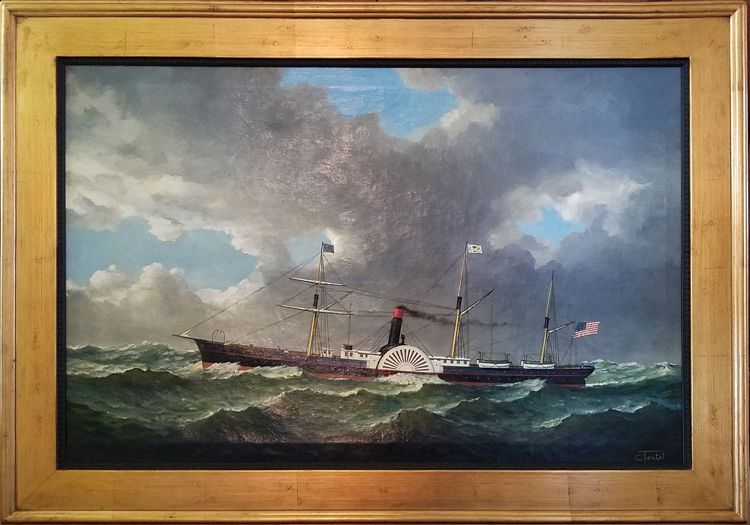OIL PAINTING OF
“CENTRAL AMERICA”
By C. Teutel
 Oil on canvas
Oil on canvas
Viewing area 34 3/4″ x 22 3/4″ Framed 42 3/4″ x 30 3/4″ x 1 1/2″
Signed: bottom right,C. Teutel
Presented is a beautiful and very large oil painting of the ship “Central America”, a Paddle Steam/Sailing vessel by C. Teutel. Although we have not been able to find any information on the artist, from the backing, stretcher, etc., we’re of the opinion that this painting was done during the last half of the 19th century, after the sinking of this fine ship. Below is the story of the “Ship of Gold”.
 SS Central America, known as the Ship of Gold, was a 280-foot (85 m) sidewheel steamer that operated between Central America and the eastern coast of the United States during the 1850s. She was originally named the SS George Law, after Mr. George Law of New York. The ship sank in a hurricane in September 1857, along with 425 of her 578 passengers and crew and 30,000 pounds (14,000 kg) of gold, contributing to the Panic of 1857 On 3 September 1857, 477 passengers and 101 crew left the Panamanian port of Colón, sailing for
SS Central America, known as the Ship of Gold, was a 280-foot (85 m) sidewheel steamer that operated between Central America and the eastern coast of the United States during the 1850s. She was originally named the SS George Law, after Mr. George Law of New York. The ship sank in a hurricane in September 1857, along with 425 of her 578 passengers and crew and 30,000 pounds (14,000 kg) of gold, contributing to the Panic of 1857 On 3 September 1857, 477 passengers and 101 crew left the Panamanian port of Colón, sailing for
New York City under the command of William Lewis Herndon. The ship was laden with 10 short tons (9.1 t) of gold prospected during the California Gold Rush. After a stop in Havana, the ship continued north.

Map plotting the track and the intensity of the storm, according to the Saffir’Simpson scale
On 9 September 1857, the ship was caught up in aCategory 2 hurricane while off the coast of the Carolinas. By 11 September, the 105 mph (170 km/h) winds and heavy seas had shredded her sails, she was taking on water, and her boiler was threatening to fail. A leak in one of the seals between the paddle wheel shafts and the ship’s sides sealed its fate. At noon that day, her boiler could no longer maintain fire. Steam pressure dropped, shutting down both the bilge pumps. Also, the paddle wheels that kept her pointed into the wind failed as the ship settled by the stern. The passengers and crew flew the ship’s flag inverted (a distress sign in the US) to signal a passing ship. No one came.
 A depiction of the sinking
A depiction of the sinking
A bucket brigade was formed, and her passengers and crew spent the night fighting a losing battle against the rising water. During the calm of the hurricane, attempts were made to get the boiler running again, but these failed. The second half of the storm then struck. The ship was now on the verge of foundering. Without power, the ship was carried along with the storm and the strong winds would not abate. The next morning, September 12, two ships were spotted, including the brig Marine. Only 153 passengers, primarily women and children, made their way over in lifeboats. The ship remained in an area of intense winds and heavy seas that pulled the ship and most of her company away from rescue. Central America sank at 8:00 that evening. As a consequence of the sinking, 425 people were killed. A Norwegian bark, Ellen, rescued an additional 50 from the waters. Another three were picked up over a week later in a lifeboat.
In the immediate aftermath of the sinking, greatest attention was paid to the loss of life, which was described as “appalling” and as having “no parallel” among American navigation disasters. At the time of her sinking, Central America carried gold then valued at approximately $8,000,000 (modern monetarily 2019 dollar equivalent to $550 million, assuming a gold value of $1,528.40 per troy ounce. The loss shook public confidence in the economy, and contributed to the Panic of 1857. The valuation of the ship itself was substantially less than those lost in other disasters of the period, being $140,000 (equivalent to $3,840,000 in 2019).
Commander William Lewis Herndon, a distinguished officer who had served during the Mexican-American War and explored the Amazon Valley, was captain of Central America, and went down with his ship. Two US Navy ships were later named USS Herndon in his honor, as was the town of Herndon, Virginia. Two years after the sinking, his daughter Ellen married Chester Alan Arthur, later the 21st President of the United States.



 Back showing the original stretcher
Back showing the original stretcher
CONDITION:
The stretcher and back of the canvas show age. However, the painting went through a complete restoration by J.W. Simmonds in 2000. It was originally from the Forbes Collection in White Plains, N.Y. Consequently, the painting and frame are pristine.

 Back showing detail of tag
Back showing detail of tag
